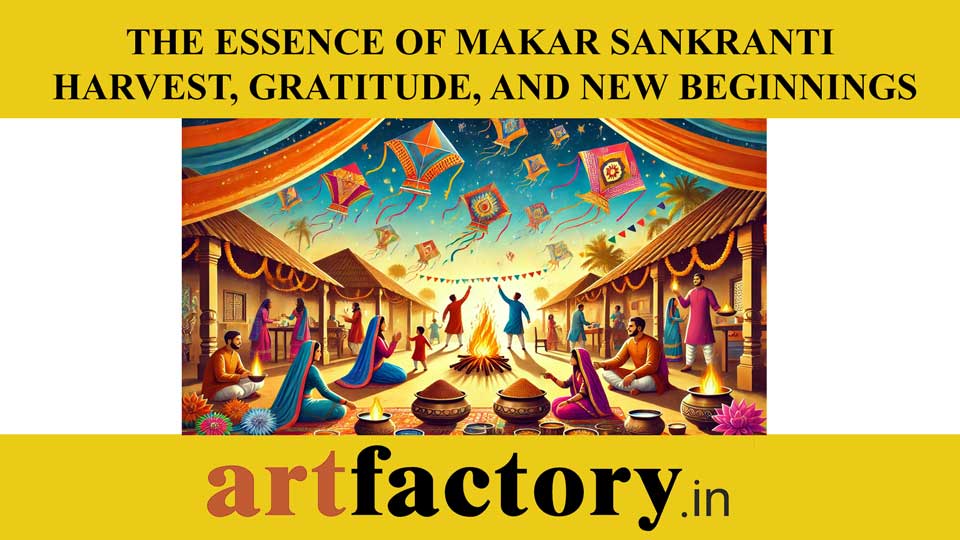
The Essence of Makar Sankranti: Harvest, Gratitude, and New Beginnings
Makar Sankranti is a significant Hindu festival celebrated across India and Nepal, marking the transition of the Sun into the zodiac sign of Capricorn (Makara). It usually falls on 14th or 15th January every year and is observed with various traditions that differ by region. The festival signifies the end of the winter solstice and the beginning of longer days as the Sun starts its northward journey, known as Uttarayan.
Spiritual Significance
Surya Devta Worship:
The festival is dedicated to Surya (Sun God), symbolizing energy, wisdom, and vitality.People offer gratitude for the Sun's energy, which sustains life on Earth.Uttarayana:
It marks the beginning of an auspicious period in Hindu tradition, believed to be a time of spiritual growth and good deeds.Karma and Dharma:
Makar Sankranti signifies the importance of doing good deeds (karma) and following the path of righteousness (dharma).End of Inauspicious Period:
With this day, the six-month-long Dakshinayana (Sun's southward journey) ends, symbolizing the decline of negativity and the rise of positivity.
Cultural Importance
Harvest Festival:
It celebrates the harvest of Rabi crops and is associated with abundance and gratitude.Farmers thank nature for a bountiful harvest.Punya Kaal:
Taking a holy dip in rivers like the Ganga, Yamuna, and Godavari on this day is believed to cleanse sins and bring spiritual merit.Charity:
Donating food, clothes, and other essentials is considered highly auspicious. Items like til (sesame seeds), gur (jaggery), and blankets are commonly offered.
Regional Celebrations
- Uttar Pradesh: Known as Khichdi Sankranti, where people cook and share khichdi.
- Maharashtra: Exchange of til-gud (sesame-jaggery sweets) with the phrase, "Til gul ghya, god god bola" (Take sesame and jaggery, and speak sweetly).
- Gujarat: Celebrated with kite flying, symbolizing the joy and freedom of the Uttarayana phase.
- Tamil Nadu: Observed as Pongal, focusing on thanksgiving to nature.
- Punjab: Celebrated as Lohri the day before, followed by Maghi.
- Assam: Known as Magh Bihu or Bhogali Bihu, emphasizing feasts and bonfires.
Ritual Practices
- Surya Namaskar: Practicing yoga and offering water to the Sun.
- Special Foods:Sesame and jaggery sweets like til laddoos and puran poli are prepared, symbolizing unity and harmony.
- Bonfires and Dances:Bonfires are lit in some regions, symbolizing the destruction of negativity.
Makar Sankranti blends spirituality, cultural vibrancy, and gratitude, making it a cherished festival across India.
Short Questions and Answers
What is the meaning of Makar Sankranti?
Makar Sankranti marks the Sun's transition into Capricorn (Makar Rashi) and the beginning of Uttarayana, symbolizing spiritual growth and positivity.Why is Makar Sankranti celebrated?
Makar Sankranti celebrates the harvest season, Surya worship, and the transition to an auspicious phase in Hinduism.What are the rituals of Makar Sankranti?
Rituals include Surya worship, taking holy dips in rivers, charity, kite flying, and preparing sesame-jaggery sweets.Why is Uttarayana significant in Hinduism?
Uttarayana marks the Sun's northward movement, considered an auspicious period for spiritual practices and good deeds.How is Makar Sankranti celebrated in different states?
Makar Sankranti is celebrated with kite flying in Gujarat, Pongal in Tamil Nadu, Lohri in Punjab, and Khichdi Sankranti in Uttar Pradesh.Why is til and gur important in Makar Sankranti?
Sesame (til) and jaggery (gur) symbolize unity and harmony, and their consumption is believed to bring warmth and energy during winter.What is the significance of taking a holy dip on Makar Sankranti?
Taking a dip in holy rivers is believed to cleanse sins and bring spiritual blessings on Makar Sankranti.What is the astrological importance of Makar Sankranti?
It marks the Sun's entry into Capricorn, symbolizing a shift toward positivity and prosperity.What are some traditional foods prepared on Makar Sankranti?
Foods like til laddoos, khichdi, puran poli, and sesame-jaggery sweets are traditionally prepared.
For more details,visit:https://artfactory.in/

Comments : (0)